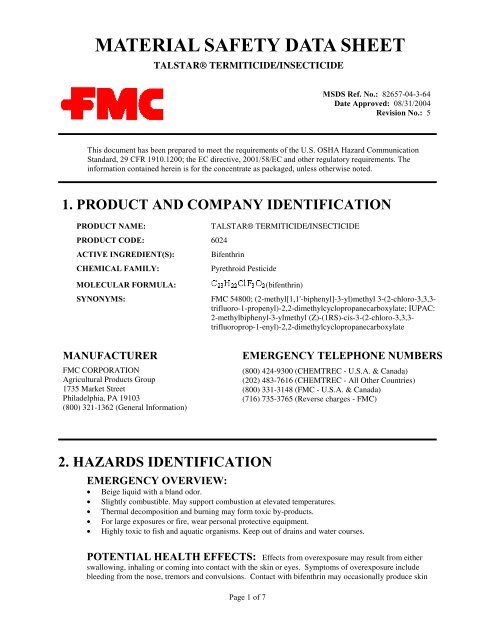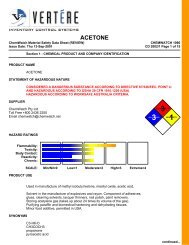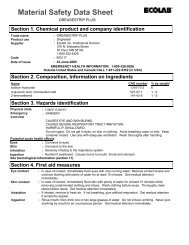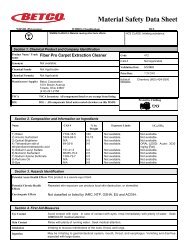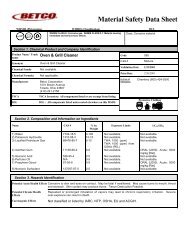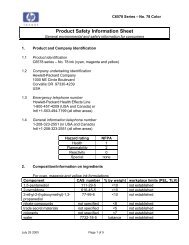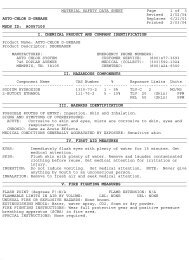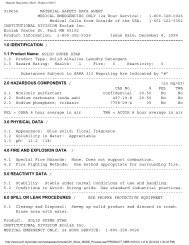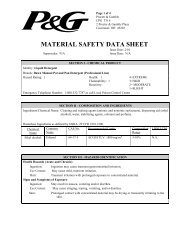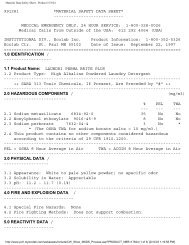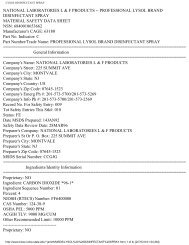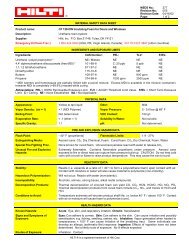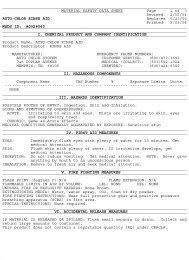TALSTAR® TERMITICIDE/INSECTICIDE
TALSTAR® TERMITICIDE/INSECTICIDE
TALSTAR® TERMITICIDE/INSECTICIDE
Create successful ePaper yourself
Turn your PDF publications into a flip-book with our unique Google optimized e-Paper software.
MATERIAL SAFETY DATA SHEET<br />
TALSTAR® <strong>TERMITICIDE</strong>/<strong>INSECTICIDE</strong><br />
MSDS Ref. No.: 82657-04-3-64<br />
Date Approved: 08/31/2004<br />
Revision No.: 5<br />
This document has been prepared to meet the requirements of the U.S. OSHA Hazard Communication<br />
Standard, 29 CFR 1910.1200; the EC directive, 2001/58/EC and other regulatory requirements. The<br />
information contained herein is for the concentrate as packaged, unless otherwise noted.<br />
1. PRODUCT AND COMPANY IDENTIFICATION<br />
PRODUCT NAME:<br />
TALSTAR® <strong>TERMITICIDE</strong>/<strong>INSECTICIDE</strong><br />
PRODUCT CODE: 6024<br />
ACTIVE INGREDIENT(S): Bifenthrin<br />
CHEMICAL FAMILY:<br />
Pyrethroid Pesticide<br />
MOLECULAR FORMULA:<br />
SYNONYMS:<br />
(bifenthrin)<br />
FMC 54800; (2-methyl[1,1'-biphenyl]-3-yl)methyl 3-(2-chloro-3,3,3-<br />
trifluoro-1-propenyl)-2,2-dimethylcyclopropanecarboxylate; IUPAC:<br />
2-methylbiphenyl-3-ylmethyl (Z)-(1RS)-cis-3-(2-chloro-3,3,3-<br />
trifluoroprop-1-enyl)-2,2-dimethylcyclopropanecarboxylate<br />
MANUFACTURER<br />
FMC CORPORATION<br />
Agricultural Products Group<br />
1735 Market Street<br />
Philadelphia, PA 19103<br />
(800) 321-1362 (General Information)<br />
EMERGENCY TELEPHONE NUMBERS<br />
(800) 424-9300 (CHEMTREC - U.S.A. & Canada)<br />
(202) 483-7616 (CHEMTREC - All Other Countries)<br />
(800) 331-3148 (FMC - U.S.A. & Canada)<br />
(716) 735-3765 (Reverse charges - FMC)<br />
2. HAZARDS IDENTIFICATION<br />
EMERGENCY OVERVIEW:<br />
• Beige liquid with a bland odor.<br />
• Slightly combustible. May support combustion at elevated temperatures.<br />
• Thermal decomposition and burning may form toxic by-products.<br />
• For large exposures or fire, wear personal protective equipment.<br />
• Highly toxic to fish and aquatic organisms. Keep out of drains and water courses.<br />
POTENTIAL HEALTH EFFECTS: Effects from overexposure may result from either<br />
swallowing, inhaling or coming into contact with the skin or eyes. Symptoms of overexposure include<br />
bleeding from the nose, tremors and convulsions. Contact with bifenthrin may occasionally produce skin<br />
Page 1 of 7
TALSTAR® <strong>TERMITICIDE</strong>/<strong>INSECTICIDE</strong> (82657-04-3-64) Date: 08/31/2004<br />
sensations such as rashes, numbing, burning or tingling. These skin sensations are reversible and usually<br />
subside within 12 hours.<br />
MEDICAL CONDITIONS AGGRAVATED: None presently known.<br />
3. COMPOSITION / INFORMATION ON INGREDIENTS<br />
Chemical Name CAS# Wt.% EC No. EC Class<br />
Bifenthrin 82657-04-3 7.9 None R25; R50/53; S46-57<br />
Propylene Glycol 57-55-6
TALSTAR® <strong>TERMITICIDE</strong>/<strong>INSECTICIDE</strong> (82657-04-3-64) Date: 08/31/2004<br />
FIRE FIGHTING PROCEDURES: Isolate fire area. Evacuate downwind. Wear full<br />
protective clothing and self-contained breathing apparatus. Do not breathe smoke, gases or vapors<br />
generated.<br />
6. ACCIDENTAL RELEASE MEASURES<br />
RELEASE NOTES: Isolate and post spill area. Wear protective clothing and personal protective<br />
equipment as prescribed in Section 8, "Exposure Controls/Personal Protection". Keep unprotected persons<br />
and animals out of the area.<br />
Keep material out of lakes, streams, ponds and sewer drains. Dike to confine spill and absorb with a noncombustible<br />
absorbent such as clay, sand or soil. Vacuum, shovel or pump waste into a drum and label<br />
contents for disposal.<br />
To clean and neutralize spill area, tools and equipment, wash with a suitable solution of caustic or soda ash,<br />
and an appropriate alcohol (i.e., methanol, ethanol or isopropanol). Follow this by washing with a strong<br />
soap and water solution. Absorb, as above, any excess liquid and add to the drums of waste already<br />
collected. Repeat if necessary. Dispose of drummed waste according to the method outlined in Section 13,<br />
"Disposal Considerations".<br />
7. HANDLING AND STORAGE<br />
HANDLING AND STORAGE: Store in a cool, dry, well-ventilated place. Do not use or<br />
store near heat, open flame or hot surfaces. Store in original containers only. Keep out of reach of children<br />
and animals. Do not contaminate other pesticides, fertilizers, water, food or feed by storage or disposal.<br />
8. EXPOSURE CONTROLS / PERSONAL PROTECTION<br />
EXPOSURE LIMITS<br />
Chemical Name ACGIH OSHA Supplier<br />
Propylene Glycol<br />
10.0 mg/m 3 (WEEL)<br />
ENGINEERING CONTROLS: Use local exhaust at all process locations where vapor or<br />
mist may be emitted. Ventilate all transport vehicles prior to unloading.<br />
PERSONAL PROTECTIVE EQUIPMENT<br />
EYES AND FACE: For splash, mist or spray exposure, wear chemical protective goggles<br />
or a face shield.<br />
RESPIRATORY: For splash, mist or spray exposure wear, as a minimum, a properly<br />
fitted air-purifying respirator with an organic vapor cartridge (OV) or canister with any R, P or HE<br />
Page 3 of 7
TALSTAR® <strong>TERMITICIDE</strong>/<strong>INSECTICIDE</strong> (82657-04-3-64) Date: 08/31/2004<br />
prefilter (approved by U.S. NIOSH/MSHA, EU CEN or comparable certification organization).<br />
Respirator use and selection must be based on airborne concentrations.<br />
PROTECTIVE CLOTHING: Depending upon concentrations encountered, wear<br />
coveralls or long-sleeved uniform and head covering. For larger exposures as in the case of spills,<br />
wear full body cover barrier suit, such as a PVC suit. Leather items - such as shoes, belts and<br />
watchbands - that become contaminated should be removed and destroyed. Launder all work<br />
clothing before reuse (separately from household laundry).<br />
GLOVES: Wear chemical protective gloves made of materials such as rubber, neoprene, or<br />
PVC. Thoroughly wash the outside of gloves with soap and water prior to removal. Inspect<br />
regularly for leaks.<br />
WORK HYGIENIC PRACTICES: Clean water should be available for washing in case of<br />
eye or skin contamination. Wash skin prior to eating, drinking or using tobacco. Shower at the end of the<br />
workday.<br />
COMMENTS:<br />
Personal protective recommendations for mixing or applying this product are prescribed on the product<br />
label. Information stated above provides useful, additional guidance for individuals whose use or handling<br />
of this product is not guided by the product label.<br />
9. PHYSICAL AND CHEMICAL PROPERTIES<br />
ODOR:<br />
Bland<br />
APPEARANCE:<br />
Beige liquid<br />
DENSITY / WEIGHT PER VOLUME: 8.53 lb/gal. (1024 g/L)<br />
FLASH POINT:<br />
> 100 °C (> 212 °F) (TCC)<br />
MOLECULAR WEIGHT:<br />
422.88 (bifenthrin)<br />
pH: 6.7<br />
SOLUBILITY IN WATER:<br />
Disperses<br />
SPECIFIC GRAVITY: 1.024 @ 20°C (water =1)<br />
10. STABILITY AND REACTIVITY<br />
CONDITIONS TO AVOID:<br />
STABILITY:<br />
POLYMERIZATION:<br />
HAZARDOUS DECOMPOSITION PRODUCTS:<br />
Excessive heat and fire.<br />
Stable<br />
Will not occur<br />
Carbon monoxide, carbon dioxide, chlorine,<br />
fluorine, hydrogen chloride and hydrogen fluoride.<br />
Page 4 of 7
TALSTAR® <strong>TERMITICIDE</strong>/<strong>INSECTICIDE</strong> (82657-04-3-64) Date: 08/31/2004<br />
11. TOXICOLOGICAL INFORMATION<br />
EYE EFFECTS: Practically non-irritating<br />
SKIN EFFECTS: Non-irritating<br />
DERMAL LD 50 : > 2,000 mg/kg (rabbit)<br />
ORAL LD 50 : 632 mg/kg (rat)<br />
INHALATION LC 50 : 11.58 mg/l (1 h) (rat)<br />
ACUTE EFFECTS FROM OVEREXPOSURE: This product has low oral, dermal,<br />
and inhalation toxicity. It is practically non-irritating to the eyes and non-irritating to the skin. Large doses<br />
of bifenthrin ingested by laboratory animals produced signs of toxicity including convulsions, tremors and<br />
bloody nasal discharge. Bifenthrin does not cause acute delayed neurotoxicity. Experience to date indicates<br />
that contact with bifenthrin may occasionally produce skin sensations such as rashes, numbing, burning or<br />
tingling. These sensations are reversible and usually subside within 12 hours. In humans, ingestion of large<br />
amounts of propylene glycol has resulted in symptoms of reversible central nervous system depression<br />
including stupor, rapid breathing and heartbeat, profuse sweating and seizures.<br />
CHRONIC EFFECTS FROM OVEREXPOSURE: No data available for the<br />
formulation. In studies with laboratory animals, bifenthrin did not cause reproductive toxicity or<br />
teratogenicity. Tremors were associated with repeated exposure of laboratory animals to bifenthrin. In<br />
lifetime feeding studies conducted with rodents, a slight increase in the incidence of urinary bladder tumors<br />
at the highest dose in male mice was considered to be an equivocal response, not evidence of a clear<br />
compound-related effect. The overall absence of genotoxicity has been demonstrated in mutagenicity tests<br />
with bifenthrin. Repeated overexposure to propylene glycol can produce central nervous system depression,<br />
hemolysis and minimal kidney damage.<br />
CARCINOGENICITY:<br />
NTP:<br />
IARC:<br />
OSHA:<br />
OTHER:<br />
Not listed<br />
Not listed<br />
Not listed<br />
Not Listed (ACGIH)<br />
12. ECOLOGICAL INFORMATION<br />
Unless otherwise indicated, the data presented below are for the active ingredient.<br />
ENVIRONMENTAL DATA: In soil, bifenthrin is stable over a wide pH range and degrades<br />
at a slow rate that is governed by soil characteristics. Bifenthrin will also persist in aquatic sediments.<br />
Bifenthrin has a high Log Pow (>6.0), a high affinity for organic matter, and is not mobile in soil.<br />
Page 5 of 7
TALSTAR® <strong>TERMITICIDE</strong>/<strong>INSECTICIDE</strong> (82657-04-3-64) Date: 08/31/2004<br />
Therefore, there is little potential for movement into ground water. There is the potential for bifenthrin to<br />
bioconcentrate (BCF = 11, 750).<br />
ECOTOXICOLOGICAL INFORMATION: Bifenthrin is highly toxic to fish and<br />
aquatic arthropods and LC 50 values range from 0.0038 to 17.8 µg/L. In general, the aquatic arthropods are<br />
the most sensitive species. Care should be taken to avoid contamination of the aquatic environment.<br />
Bifenthrin had no effect on mollusks at its limit of water solubility. Bifenthrin is only slightly toxic to both<br />
water fowl and upland game birds (LD 50 values range from 1,800 mg/kg to >2,150 mg/kg).<br />
13. DISPOSAL CONSIDERATIONS<br />
DISPOSAL METHOD: Open dumping or burning of this material or its packaging is prohibited.<br />
If spilled material cannot be disposed of by use according to label instructions, an acceptable method of<br />
disposal is to incinerate in accordance with local, state and national environmental laws, rules, standards<br />
and regulations. However, because acceptable methods of disposal may vary by location and regulatory<br />
requirements may change, the appropriate agencies should be contacted prior to disposal.<br />
EMPTY CONTAINER: Non-returnable containers that held this material should be cleaned,<br />
prior to disposal, by triple rinsing. Containers which held this material may be cleaned by being triplerinsed,<br />
and recycled, with the rinsate being incinerated. Do not cut or weld metal containers. Vapors that<br />
form may create an explosion hazard.<br />
14. TRANSPORT INFORMATION<br />
U.S. DEPARTMENT OF TRANSPORTATION (DOT)<br />
PACKAGING TYPE:<br />
ADDITIONAL INFORMATION:<br />
Non-Bulk<br />
This material is not a hazardous material as<br />
defined by US Department of<br />
Transportation at 49 CFR Parts 100 through<br />
185.<br />
15. REGULATORY INFORMATION<br />
UNITED STATES<br />
SARA TITLE III (SUPERFUND AMENDMENTS AND REAUTHORIZATION ACT)<br />
SECTION 302 EXTREMELY HAZARDOUS SUBSTANCES (40 CFR 355, APPENDIX A):<br />
Not listed<br />
Page 6 of 7
TALSTAR® <strong>TERMITICIDE</strong>/<strong>INSECTICIDE</strong> (82657-04-3-64) Date: 08/31/2004<br />
SECTION 311 HAZARD CATEGORIES (40 CFR 370):<br />
Immediate, Delayed<br />
SECTION 312 THRESHOLD PLANNING QUANTITY (40 CFR 370):<br />
The Threshold Planning Quantity (TPQ) for this product, if treated as a mixture, is 10,000 lbs;<br />
however, this product contains the following ingredients with a TPQ of less than 10,000 lbs.:<br />
None<br />
SECTION 313 REPORTABLE INGREDIENTS (40 CFR 372):<br />
This product contains the following ingredients subject to Section 313 reporting requirements:<br />
Bifenthrin<br />
FEDERAL <strong>INSECTICIDE</strong> FUNGICIDE RODENTICIDE ACT<br />
U.S. EPA Signal Word: CAUTION<br />
INTERNATIONAL LISTINGS<br />
Australian Hazard Code: 3XE<br />
16. OTHER INFORMATION<br />
REVISION SUMMARY:<br />
This MSDS replaces Revision #4, dated December 15, 2003.<br />
Changes in information are as follows:<br />
New Format, as well as:<br />
Section 3 (Composition / Information on Ingredients)<br />
Section 14 (Transport Information)<br />
Section 16 (Other Information)<br />
Talstar and FMC Logo - FMC Trademarks<br />
© 2004 FMC Corporation. All Rights Reserved.<br />
FMC Corporation believes that the information and recommendations contained herein (including data and<br />
statements) are accurate as of the date hereof. NO WARRANTY OF FITNESS FOR ANY PARTICULAR<br />
PURPOSE, WARRANTY OF MERCHANTABILITY, OR ANY OTHER WARRANTY, EXPRESSED<br />
OR IMPLIED, IS MADE CONCERNING THE INFORMATION PROVIDED HEREIN. The information<br />
provided herein relates only to the specific product designated and may not be applicable where such<br />
product is used in combination with any other materials or in any process. Use of this product is regulated<br />
by the U.S. Environmental Protection Agency (EPA). It is a violation of Federal law to use this product in a<br />
manner inconsistent with its labeling. Further, since the conditions and methods of use are beyond the<br />
control of FMC Corporation, FMC Corporation expressly disclaims any and all liability as to any results<br />
obtained or arising from any use of the product or reliance on such information.<br />
Page 7 of 7


